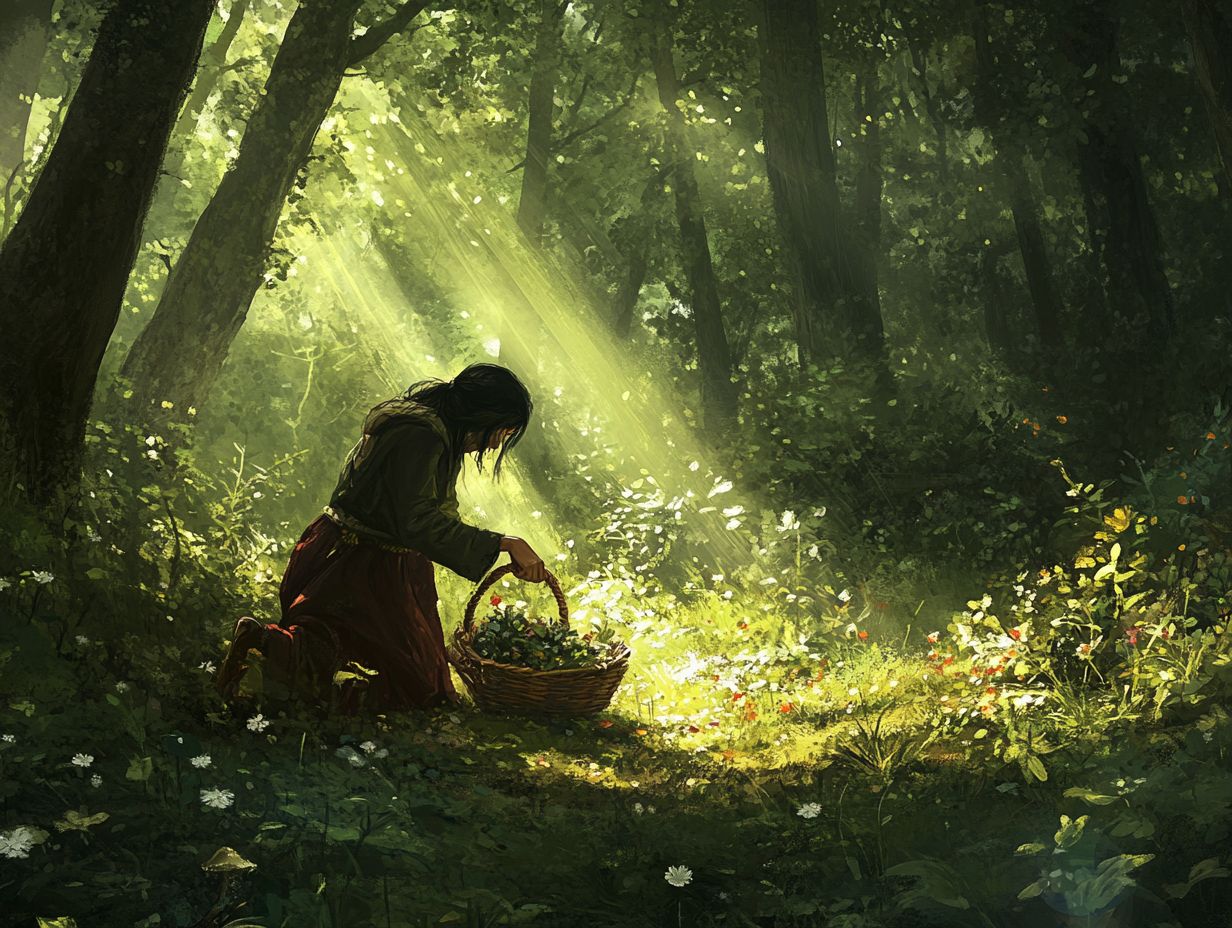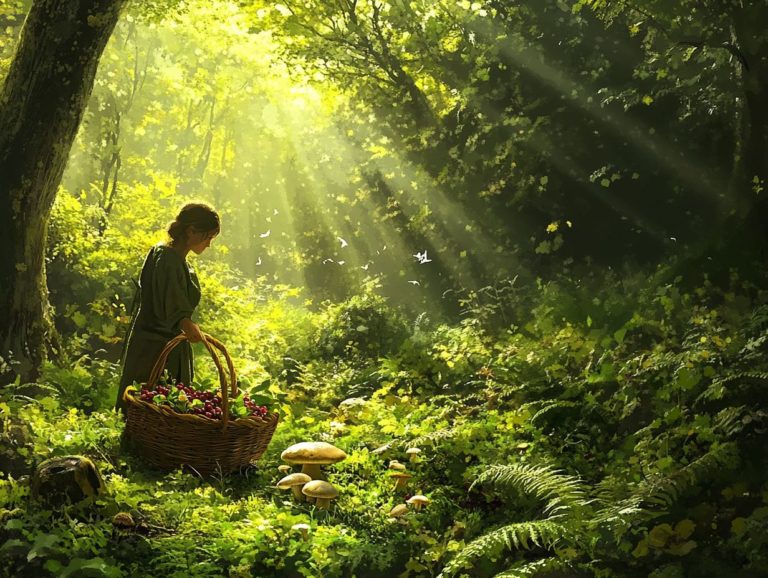5 Creative Foraging Techniques to Enhance Skills
Foraging transcends mere food gathering; it s an exhilarating adventure that deepens your connection to nature and sharpens your senses. It reveals the intricate relationships among wildlife populations and their habitats.
This article delves into five techniques designed to elevate your foraging skills. You ll enhance your understanding of foraging patterns and how living things interact with each other and their environment. You ll learn to use signs in nature to navigate your surroundings and identify edible plants, wildlife, and animal tracks with confidence, including those of birds like Black Skimmers and herons. It highlights the significance of understanding seasonal changes, exercising patience, and keenly observing your environment.
You’ll uncover the mental and physical benefits of food foraging, along with essential safety tips and guidance on how to create foraging challenges to seamlessly integrate this enriching practice into your daily routine. This fosters outdoor learning and personal development.
Get ready for an exciting adventure in the wild!
Contents
- Key Takeaways:
- 1. Use Signs in Nature for Navigation and Wildlife Insights
- 2. Utilizing Your Senses to Identify Edible Plants
- 3. Learning to Recognize Tracks and Signs of Animals
- 4. Understanding the Seasons and Their Effects on Foraging
- 5. Practicing Patience and Observation in the Wild
- How Can Foraging Benefit Your Mind and Body?
- Frequently Asked Questions
Key Takeaways:

- Natural signs in nature can be used to navigate and find your way while foraging, improving your orienteering skills and leading to unique foraging opportunities.
- Utilizing your senses, such as sight, smell, and taste, can help you identify edible plants and enhance your foraging abilities.
- Learning to recognize animal tracks and signs can lead you to potential food sources and sharpen your observation skills in the wild.
Navigating through wild spaces while foraging requires you to understand signs in nature, which serve as essential guides for locating food sources such as edible plants, fruits, and aquatic vegetation. By mastering these techniques, you can elevate your foraging skills and deepen your connection with the natural ecosystems surrounding you. This knowledge promotes outdoor learning and seamlessly integrates ecological concepts into practical applications while encouraging a creative exploration of the environment that is both enriching and sustainable.
Natural signs include distinctive landforms like rivers, hills, and valleys that indicate specific ecosystems and their corresponding edible treasures. Vegetation patterns, such as the presence of particular trees or wildflowers, signal where you might uncover certain fruits or nuts. Animal tracks can reveal the presence of wildlife, including birds foraging and mammals, guiding you to habitats rich in resources.
For instance, the nesting behaviors of Black Skimmers can hint at nearby coastal food sources, while herons often perch near water bodies teeming with fish, helping you identify prime fishing spots. Your foraging methods may vary widely based on geography; in coastal areas, you might focus on gathering shellfish, while in forests, nut and berry harvesting could take precedence.
2. Utilizing Your Senses to Identify Edible Plants
The ability to effectively utilize your senses is essential for identifying edible plants in the wild. This paves the way for a successful foraging experience that allows you to create nutritious meals using unique ingredients from the environment.
Being attuned to what you see can help you spot the vibrant green leaves of wild spinach. The unmistakable aroma of freshly crushed basil can guide you straight to delicious finds!
Touch, too, plays a vital role; the softness of a dandelion leaf indicates its edibility, while the slight bitterness of a wild mustard plant hints at its culinary potential.
Engaging in local culinary courses not only sharpens these sensory skills but also equips you with practical techniques for safely preparing and savoring foraged foods. You are encouraged to partake in outdoor learning activities, enhancing your confidence in identifying and appreciating the 7 essential foraging skills for everyone that nature has to offer.
If you have any experiences to share or questions about foraging, feel free to reach out! We d love to hear from you!
3. Learning to Recognize Tracks and Signs of Animals
Recognizing tracks and signs of animals in their natural habitats is an invaluable skill for you as a forager. It offers insights into wildlife populations and their behaviors while enhancing your problem-solving abilities in food foraging.
By observing the shapes, sizes, and patterns of tracks, you can decode the stories they tell about animal movements and habits. Different species leave unique trails. For instance, a deer s heart-shaped hoofprints are distinct from a rabbit’s small, rounded footprints.
Practical exercises, like creating a simple tracking journal, will sharpen your observation skills. Record the location, size, and surrounding signs like animal droppings (scat) or chewed vegetation to deepen your understanding of local wildlife dynamics.
This meticulous approach reveals the presence of certain animals and helps you predict their behaviors. This enriches your foraging experience and grounds it in ecological awareness.
4. Understanding the Seasons and Their Effects on Foraging

Understanding how seasonal changes influence foraging patterns is crucial for you as a forager. These shifts directly affect food availability, wildlife behavior, and the dynamics of natural ecosystems.
Each season offers a unique variety: from vibrant wild greens in spring to luscious berries in summer and rich nuts in fall. Winter poses distinct challenges, prompting you to adapt your strategies and seek storable foods or hunting opportunities.
The rapid pace of urbanization threatens these natural rhythms, disrupting habitats and animal migrations. This makes locating familiar food sources increasingly difficult. Conservation efforts, like habitat restoration and creating protected areas, are essential to safeguarding these ecosystems.
By embracing sustainable foraging practices and educating your community about seasonal patterns, you can cultivate respect for nature. This ensures that future generations can also enjoy the treasures of the land.
5. Practicing Patience and Observation in the Wild
Practicing patience and keen observation while foraging enhances your ability to uncover unique opportunities. It grants you a deeper understanding of ecological dynamics and the natural world.
Immerse yourself in your surroundings to cultivate awareness of the environment. Recognize subtle signs that often escape the untrained eye. Each moment spent observing intricate details the sway of leaves or rustle of underbrush invites clarity and creativity. This can lead you to unexpected culinary gems.
Embracing a slower pace deepens your connection to nature and fosters awe and appreciation. Whether wandering through lush forests or navigating coastal shores, savoring the journey unlocks a treasure trove of learning experiences.
How Can Foraging Benefit Your Mind and Body?
Foraging presents a wealth of benefits for both your mind and body. It’s a fantastic way to learn outdoors, enhances your mental health through real interaction with nature, and promotes physical activity as you explore wild spaces in search of unique ingredients. Additionally, incorporating foraging techniques to engage children can make the experience even more enriching for families.
When you immerse yourself in this activity, you can significantly reduce stress. Wandering through serene forests or vibrant meadows allows you to disconnect from the daily grind and truly immerse yourself in the present moment. The fresh air and physical exertion work wonders for your mood. The thrill of uncovering edible treasures also gives your self-esteem a delightful boost. Embracing foraging also boosts your fitness levels, thanks to the diverse terrains and varied activities it encompasses.
To enrich your foraging experience, consider enrolling in cooking classes that focus on preparing foraged foods. These classes will teach you how to transform your wild finds into delicious meals, enhancing your overall well-being and deepening your connection to both food and nature.
What Safety Precautions Should Be Taken When Foraging?
Prioritizing safety precautions is paramount when engaging in food foraging. It helps you avoid misidentifying edible plants and ensures a respectful interaction with local wildlife as you observe their natural behavior.
By understanding which plants are toxic and familiarizing yourself with local wildlife patterns, you can greatly improve your enjoyment and safety. Carrying tools for accurate identification, such as field guides or plant apps, provides quick access to information whenever questions arise. Maintaining a safe distance from wildlife particularly during nesting seasons or when animals are caring for their young is crucial for your safety and the protection of local ecosystems.
Foraging with a partner is advisable; an extra set of eyes can help spot potential dangers and confirm the identification of the treasures you collect.
What Tools and Equipment Are Useful for Foraging?

Utilizing the right tools and equipment can significantly elevate your foraging experience, making it easier for you to identify and collect edible plants while fostering a deeper connection with the great outdoors during your outdoor learning journey.
Among the essentials, field guides truly shine, offering invaluable insights into local flora and helping you safely identify foraged items. Equally important are baskets for collecting wild plants, which make it easy to transport your finds while ensuring they remain intact and fresh. A sturdy knife is another must-have, aiding you in the precise harvesting of plants, whether you re cutting herbs or gathering mushrooms.
If you re engaging in cooking classes, investing in quality utensils can transform your foraged bounty into exquisite dishes. Consider adding items like airtight containers for preserving herbs and foraging gloves for safe handling, which can be particularly useful for risk-prone individuals. This thoughtful assortment not only complements your culinary pursuits but also enriches the overall foraging adventure.
How Can Foraging Help in Sustainable Living?
Foraging holds a vital place in promoting sustainable living. It offers you access to local food supplies while reducing reliance on industrial agriculture.
This practice strengthens your connection to conservation efforts within your community, supported by various ecological concepts. By embracing this time-honored method, you can significantly decrease your carbon footprint, which is the impact our activities have on the environment.
Foraging eliminates the transportation needs associated with conventional food sourcing. It also encourages responsible harvesting, ensuring that ecosystems remain balanced and resilient, even as urbanization encroaches.
As cities expand, traditional food sources often dwindle. This leads many to rely on mass-produced goods that can harm both health and the environment. Discover the thrilling bounty nature holds in your backyard with foraging!
This practice fosters a sense of stewardship and strengthens community bonds through shared experiences and knowledge of local ecosystems. Together, you create a larger network of individuals engaged in a creative exploration of their environment.
What Are Some Common Mistakes to Avoid When Foraging?
Avoiding common mistakes is crucial for your successful foraging adventures. Misidentifying edible plants or overlooking essential safety precautions can lead to harmful consequences.
- Misidentifying toxic look-alikes for edible counterparts.
- Failing to consider local wildlife behaviors, such as those of Black Skimmers or Brown Pelicans, which could impact your success.
As a beginner forager, invest time in becoming familiar with local flora and fauna. Grab a field guide today and start your foraging adventure! You might also consider enrolling in workshops led by seasoned foragers.
Creating a checklist of safe foraging practices and establishing a supportive community can significantly reduce risks and enhance your overall experience. By prioritizing preparation and education, you can explore nature s bounty with confidence.
How Can Foraging Be Incorporated into Everyday Life?
Incorporating foraging into your everyday life can elevate your culinary skills and promote sustainable living. To enhance your experience, learn how to develop your own foraging techniques and enjoy unique ingredients sourced directly from your local environment while deepening your connection with nature.
One effective approach is to organize community foraging events. Gather with like-minded individuals to learn and share discoveries, creating an environment for interactive learning.
Enrolling in culinary courses that emphasize foraged ingredients equips you with invaluable skills, igniting your creativity in the kitchen. Additionally, planning seasonal foraging trips allows you to immerse yourself in the rich diversity of available ingredients.
Together, these activities can seamlessly integrate foraging into your daily routine, enhancing both your life and your meals through novel solutions for everyday cooking, including teaching foraging techniques through play.
Frequently Asked Questions

What are foraging techniques?
Foraging techniques refer to the methods used to search for and gather food in the wild, typically by animals or humans. This includes techniques exhibited by species like the New Caledonian crows or Woodpecker Finch, known for their innovative tool use. To enhance your skills, consider exploring how to innovate your foraging techniques.
Why is foraging important?
Foraging is important because it allows us to connect with nature. It provides a source of food, such as aquatic vegetation or herbs, and can also enhance our survival skills.
What are some creative foraging techniques?
Creative foraging techniques include using traps and fishing with natural bait. You can also hunt small game with a throwing stick or collect edible plants while exploring 5 uncommon foraging techniques to try and observing wildlife like herons and buffalo.
How can foraging enhance skills?
Foraging sharpens skills such as critical thinking and problem-solving. It requires knowledge of your surroundings and adaptability, making learning engaging through hands-on experiences. Mastering essential foraging techniques can enhance your experience even further.
What are some safety precautions to take while foraging?
Always identify plants and animals correctly before foraging. Wear suitable clothing and gear, and be aware of potential hazards like poisonous plants and dangerous creatures such as ticks and spiders.
Can foraging be done in an urban environment?
Yes! You can forage in urban areas by exploring parks or green spaces filled with wild edible plants. Consider growing your own herbs, fruits, and vegetables in containers to practice sustainable living.






